In this article, I give you my XP-PEN Artist 24 Pro Pen monitor review with specs included. This is a 24-inch pen display or pen monitor. What does that mean? For those who are totally new to these things, it means you can draw right on the display with a pen and it requires a computer to drive it. That is what I have for this review.
The PC I have plugged into this monitor is not an ‘average’ computer. I just used it because it happens to be very powerful so any performance issues wouldn’t be down to it.
So, this test PC has an Intel 11th generation Core i9 and RTX 3060 GPU, which is kind of overkill for a lot of illustration purposes but again that’s the point.

The really exciting thing about the XP-PEN monitors is how much they’ve improved. You hope that companies make better and better products over time but do not expect such leaps forward.
What I mean is, that I’ve been reviewing these for several years from XP-PEN and from Huion which are two of the major more affordable alternatives to Wacom Cintiq products. And, it used to be the XP-PEN was never really that competitive with Cintiq or Cintiq Pro products in terms of the silkiness of line quality, ease of use for the driver, and display quality wasn’t as good, and all that sort of thing. And, that’s starting to change with XP-PEN Artist 24 Pro Pen monitor.

So what got better about this monitor? First off it has a 2K resolution of 2560 by 1440 instead of the usual 1080p. To be honest with the 22 to 24-inch monitors with 1080p resolution you could see the pixels and that can impact your experience. And when you’re doing artwork and you’re drawing at 1080p you might think it looks okay and then you put on a higher resolution display or print it out then you see that didn’t look as good as you thought.
So more resolution is better. Obviously, this is not there with the Wacom Cintiq Pro 24-inch which has 4K resolution but that one costs about two and a half times as much money.
The price for this one is $899.99 (MSRP). That initial price puts the XP-PEN Artist 24 Pro Pen monitor in the range far from a Cintiq Pro.
You also have USB-C on board for a single cable connection which is pretty nice. Just in case your computer doesn’t have USB-C it also comes with an HDMI cable and USB-C to USB-A adapter.
So you can go old school for the connection. But that’s a nice thing. And comparing that to a Wacom Cintiq 22 which is their more budget-oriented 22-inch pen display. That one doesn’t have USB-C. And that one’s only 1080p and that costs around $1200 (MSRP). So that’s why I’m saying the XP-PEN Artist 24 Pro Pen monitor looks pretty good for the money.
But, ultimately, it all comes to how good is the display quality and the pen performance. Happily, the pen quality is good and the display quality is good.
In terms of the metrics of the display just gauging this as a monitor in terms of color and brightness and all that sort of thing. It does pretty well. You’ve got 90% of P3 coverage on here.
Also, the XP-PEN Artist 24 Pro Pen monitor has a little over 300 units of brightness. And typically pen monitors are not that bright. So that’s pretty nice. One caveat here is that this does not have a laminated display or bonded display as it’s usually described.
Laminated display tends to be an expensive thing to do and of course, we’ll get that on the Cintiq Pro, not on the so-called ‘budget Cintiq’. And that means there’s a little bit of parallax with the pen. It’s noticeable. You’ll see that pen tip offset that’s not miscalibration of the pen but just that there is a glass above the touch layer that creates spacing.
And this is a matte display which is great and it has a tooth to it. So it’s good that your pen doesn’t skate everywhere. But it’s not permanent edge glass. That’s a more pricey kind of thing to do. It is a well-applied kind of surface overlay on this.
Disassembling the bottom cover of the device is a straightforward task. The screws are Phillips heads, with the two in the front being slightly shorter, which is important to remember during reassembly. The ventilation and speaker grilles are clearly visible, with the speakers surprisingly loud and full-sounding for such a thin and light ultrabook. While they may not replace a dedicated stereo system, they offer satisfactory audio output.
Removing the magnesium alloy cover reveals the internals of the device. The battery is prominently positioned, alongside the Adata SSD offering 512GB of storage. The inclusion of a PCIe 4 SSD is noteworthy, as such drives are still relatively rare and expensive. Additionally, there appears to be an empty spot that suggests a potential future version with dedicated graphics, although likely not at the level of an RTX 3070 due to space and cooling constraints.
For users interested in expanding storage, there’s a slot available for a second SSD, supporting a 2280 drive. The RAM slots, a rare feature in ultrabooks, are also present, allowing for memory upgrades. The device ships with a single 16GB RAM module, but there’s room for a second module to enable dual-channel memory configuration, which can provide a performance boost, especially in Intel Iris Xe graphics benchmarks.
The socketed Wi-Fi card, utilizing an Intel AX201 chip, is positioned nearby, adhering to the standard for this platform. Overall, the XPG Xenia 14 impresses with its build quality, lightweight design, and a 16:10 aspect ratio display, which is somewhat uncommon in ultrabooks. Its upgradability sets it apart from many competitors, and it offers an array of ports, including Thunderbolt 4 and a full-size SD card slot.
The decision to provide 16GB of RAM as a single module may be seen as a drawback by some users. While the intention may be to streamline upgrades and minimize wasted RAM, adding a second module for dual-channel operation can yield performance benefits. However, many users may not be aware of this or may not have access to technical support for such upgrades, particularly if purchasing from large retail stores.
In summary, the XPG Xenia 14 earns praise for its overall design and features, with the only notable criticism being the single-channel RAM configuration. Despite this, it remains a commendable ultrabook option for users seeking a blend of performance, portability, and upgradability.
XP-PEN Artist 24 Pro Pen monitor
-
Performance - 96%96%
-
Price - 95%95%
-
Value - 96%96%

